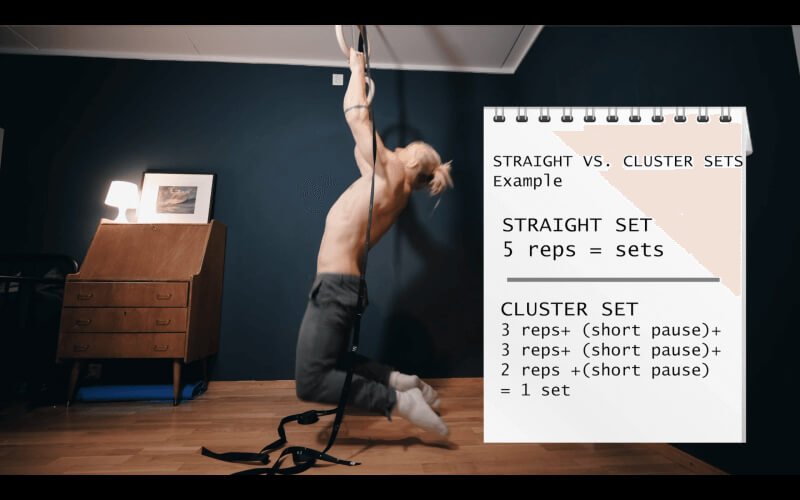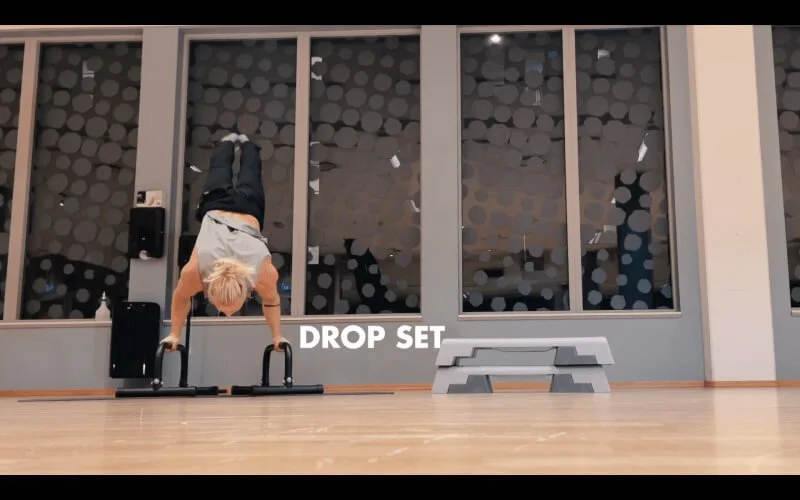6 set types for better progress in Calisthenics & Strength training
If you’ve been going to the gym and doing 3 sets of 10 reps on the bench press, and you’re wondering why you aren’t stacking that second or third 45lb plate on the bar yet, you might want to take a look at the set types you’re using. Similarly, if you’re practicing handstands or handstand push ups, and your static hold or set/rep counts are not improving, you might want to take a look at the set types you’re using. What kind of sets you use can make a difference in your motivation, as well your ability to break through plateaus. In this piece we are going to cover a whole bunch of them, so buckle up!
1. Straight Sets
This first set type is likely the one you and everyone else reading this are most familiar with: straight sets. Straight sets are pretty straightforward.. No pun intended. An example of a straight set would be 3 sets of 10 repetitions with ~1-2 minute rest between, or 5 sets of 5 repetitions with 3 min rest in between each set. Traditionally 3 sets x 10 reps would be used for hypertrophy, whereas 5 sets x 5 reps would be used to gain strength. In reality though, it’s not really about the amount of sets, or repetitions, but about intensity, volume and effort.
While there’s nothing wrong with doing good old straight sets, depending on the nature of the exercise we’re doing, we may want to include some different set types into our routine. For example, whether you’re doing a static movement such as the planche or back lever, a technical movement such as the handstand, or a semi-technical movement, such as the handstand push up, the ideal set type might be different.
There are many benefits to switching up your set types and structure!
2. Cluster Sets
check the clip out for a visual breakdown of the Cluster Set
The next set type I want to cover is called Cluster Sets. Cluster sets are when you divide a single set into several clusters/subsets. This set type is usually used for heavy/technical exercises. Rather than doing just 5 reps like you would in a straight set, one set will consist of, for example, 3 clusters of 3,3, and 2 reps. Within one cluster and between the 3,3, and 2 reps you may take up to 20 seconds of rest. With this set type you end up getting more volume without adding more sets.
An example cluster set. You can use different rep counts for each cluster to suit your goal, whether it’s strength or hypertrophy. For example a hypertrophy cluster set could look like 5 reps,5reps ,4 reps rather than 1x10 reps in a straight set.
If you use cluster sets properly, you will be able to build more strength and power in the same amount of time, while building at least as much muscle! These can also be used to force progress. They are also a great way of training semi-technical exercises, where focus, form and/or balance is important to the exercise and/or progression
3. Rest-Pause Set
A similar set structure to cluster sets is called Rest-Pause sets. This type of set is usually used to focus more on hypertrophy, and to intensify your workout. The idea is to do an exercise to failure, then do a short rest, for example 20-30 seconds, and then do the exact same exercise again, to failure, and repeat this 1-2 times.
Here’s an example suing rest-pause sets for pull-ups (or band assisted pull-up, or weighted pull-ups for that matter):
Pull ups to failure
Rest 20 seconds
Pull ups to failure
Rest 20 seconds
Pull ups to failure
Using a set type such as rest-pause you can force progress.
3.1 Rest-Pause Technical Elimination Set
Rest-pause technical elimination, check it out for a quick explanation :)
One idea for a bodyweight strength movement would be to do what I call the rest-pause-technical elimination set. Some bodyweight exercises are just too technical to be able to push yourself to failure. So if your goal is both to develop yourself technically, as well as building muscle, this set type might be a good idea. Let’s take a look at this set type with the HSPU, an exercise which is difficult to perform to failure, especially in the early days of learning the skill.
Example rest-pause-technical elimination set:
HSPUs to failure free standing
Short rest, 20-30 secs
HSPUs to failure with wall
Short rest, 20-30 secs
HSPUs to failure with wall
This way you get to train the technique of the skill you want to learn, as well as focusing on strength specific to that exercise while potentially also gaining some muscle volume.
If you’re stuck at a particular number of reps of pull ups, why not try and increase one set of rest-pause instead? In my app I use quite a few different set types based on both rest-pause sets, as well as cluster sets. This helps in overcoming the difficulty in programming for bodyweight strength skills, to improve measurability, and to improve technique and strength progress.
4. Drop Sets
Now I’d like to get into drop sets. If you’ve done weight training or bodybuilding before, you’ve heard about drop sets. You do an exercise to failure, drop the weight, do it to failure again, drop the weight, and on and on.
It may come as a surprise that this set type can be easily applied to bodyweight strength training as well and, if you’re trying to build muscle, might be worth a try. Here’s an example of how you can use drop sets with a body weight exercise:
Choose an exercise you can do 10 reps of, for example Pike Push Ups. Your set structure could look like this:
Set 1, straight set: 10 Pike Push Ups
Set 2, straight set: 10 Pike Push ups
Set 3, drop set: Pike Push ups to failure → Regular push ups to failure → knees-down push ups to failure
In this way, we are ‘dropping the weight’ by going ‘down’ to an easier progression.
A similar approach could be applied to the pull ups, for example:
Pull ups to failure
Pull ups with resistance band, to failure
Pull ups with thicker resistance band, to failure
Of course, you could do more ‘drops’ if you wanted. Here is an example of a mega super set I did, just to illustrate how far you can go with it if you so choose:
90 degree push ups to failure
Deep HSPU to failure
Freestanding HSPU to failure
Chest-to-wall HSPU to failure
Back-to-wall HSPU to failure
Pike PU to failure
Regular PU to failure
5. Static Sets
When training static exercises, such as the planche or front lever, we do Static Sets. In static sets, we count seconds rather than reps. However, there is a way that we can look at static exercises in terms of reps! From the concept of Time Under Tension(TUT), we can deduce that one rep is approximately 3 seconds (over simplified).
Being able to quantify reps for a static exercise make them much easier to work with, because we can take repetition strategies and turn them into static-hold strategies. I use this both in my own programming, as well as the programming you’ll see in my app, by implementing it into a cluster set type structure. I call this ‘collecting seconds’.
6. Super Sets
Next I’m going to go over Super Sets. Super Sets are when you combine two different exercises with little to no rest between.
6.1 Agonist super sets
It can be done the ‘agonist’ way, meaning you are using two exercises that are hitting the same muscle group. For example, you could do a HSPU progression such as pike push-up and pair it with a planche progression, or a horizontal push variation such as a progression towards one arm push-up . If doing super sets the agonist way I generally recommend choosing two exercises that hits the main muscles groups differently to increase muscular activation. Another example would be for example pairing up pull-ups and a front lever progression, or some kind of row variation.
agonist super set = two exercises back to back which work the same muscle groups
6.2 Antagonist super set
Super sets can also be done in the ‘antagonist’ way, meaning you use two exercises that target opposing muscle groups. For example, you could superset HSPU with pull ups. The ‘antagonist’ superset method is the one I usually recommend for making your workouts more efficient.
Antagonist super set = two exercises back to back which work opposing muscle groups , e.g. chest and back
Another way to do your supersets could be upper body/lower body. For example, you could superset HSPUs with squats.
6.3 Tri & Giant Sets
Moving on from Super Sets, we have tri sets. Tri sets are when you put three exercises together in the same style as a super set. You go from the first, to the second, to the third exercise with as little rest between each exercise as possible. One example of a tri set would be to do: pull ups, HSPUs, then pistol squats.
After Tri sets, you have Giant Sets. Giant Sets are when a guy has a high level of fearlessness, the likes of which earn him the title of having a ‘giant set’. In all seriousness, you might get a different definition if you look up the term using Urban Dictionary, but in the exercise realm, Giant Sets are when you combine 4 or more exercises.
Summary of set types for bodyweight training
That was a lot of information to cover… you could say it was a giant set of info. So let’s summarise:
What are the different set set types?
Straight sets , e.g. 3x10 reps
Cluster Sets: 1 set performed in three clusters, e.g. instead of one straight set of 5 reps, one cluster of 3,3, and 2 reps
Rest-Pause: Exercise to failure, rest 20-30 seconds, and repeat. That’s one set. Do 1-2 sets
Rest-pause-technical elimination: exercise to failure, rest 20-30 seconds, downgrade progression difficulty and exercise to failure, rest 20-30 seconds, etc
Static sets: any sets targeting static movements e.g. planche/front/back lever
TUT for reps: for static movements such as planche, front lever, and back lever, use any of the set types mentioned here, and use 3 seconds as one rep. For example, a cluster set of 3,3, and 2 reps, would instead be a cluster set of 9 second hold, 9 second hold, and 6 second hold
Agonist + Antagonist Super Sets - two exercises working either the same muscle group(agonist) or opposing muscle groups(antagonist)
Tri Set - combining three exercises into one set
Giant Set - combining 4 exercises into one set
Mega Set- combining more than 4 exercises into one set
Try implementing some of these different set types into your workout routine to spice things up, and let me know how it goes. If you have any questions or comments, or maybe another type of set you like to use, hit me up here, on YT, or on my IG and I will do my best to respond. Take care movers!












